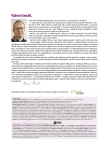New classification of breast tumors and lesions, their hormonal sensitivity a and our possibilities of prevention
Authors:
Pavel Strnad
Authors‘ workplace:
Gynekologicko-porodnická klinika 2. LF UK a FN Motol, Praha, přednosta prof. MUDr. Lukáš Rob, CSc.
Published in:
Prakt Gyn 2015; 19(1): 7-11
Category:
Oncogynecology: Review Article
Overview
During the last years five molecular subtypes of breast cancers have been characterized by molecular-genetic profiling (luminal A, B basal like, HER2 positive and normal breast like cancers). It has become apparent that estrogen receptor positive (ER+) and estrogen receptor negative (ER-) breast lesions and cancers are distinct disease with different genomic aberrations. ER+ cancers are luminal, low-grade lesions, usually with good prognosis, but ER- cancers are aggressive, high-grade lesions with a poor response to therapy and poor outcomes.
It has been claimed that mammography screening reduces breast cancer mortality by 30%, but through systematic reviews have estimated only 15% reduction. Mammographic screening is effective in the group of slowly growing, luminal cancers; however high-grade, rapid growing cancers would escape from screening interval. Some of these cancers are so aggressive that even “early” detection is too late, woman dies despite detection by mammography.
In fact, that we can´t expect next reduction of breast cancer mortality by mammographic screening, therefore our possibilities with chemoprevention of ER+ and ER+ cancer have been reviewed.
Key words:
classification of breast tumors and lesions – hormonal sensitivity of breast tumors – prevention of breast tumors
Sources
1. Abdel-Fatah TM, Powe D, Hodi Z. Morphologic and molecular evolutionary pathways of low nuclear grade invasive breast cancers and their putative precursor lesions: further evidence to support the concept of low nuclear grade breast neoplasia family. Am J Surg Pathol 2008; 32(4): 513–523.
2. Cummings SR, Ensrud K, Delmas PD et al. Lasofoxifene in postmenopausal women with osteoporosis. N Engl J Med 2010; 362(8): 686–696.
3. Cuzick J, Forbes JF, Sestak I et al. Long-term results of tamoxifen prophylaxis for breast cancer-96-month follow-up of the randomized IBIS-I trial. Natl Cancer Inst 2007; 99(4): 272–282.
4. Daneš J, Bartoňková H, Skovajsová M. Oficiální výsledky Národního programu mamografického screeningu v roce 2011. Dostupné z WWW: <http://www.mamo.cz/res/file/vysledky/vysledky-2012–11.pdf>.
5. Fisher B, Constantino JP, Wickerham DL et al. Tamoxifen for the prevention of breast cancer: current status of the National Surgical Adjuvant Breast and Bowel Project P-1 Study. J Natl Cancer Inst 2005; 97(22): 1652–1662.
6. Gos PE, Richardson H, Chlebowski R et al. National Cancer Institute of Canada Clinical Trials Group MAP.3 trial: evaluation of exmestane to prevent breast cancer in postmenopausal women. Clin Breast Cancer 2007; 7(11): 895–900.
7. G?tzsche PC. Mammography Screening: Truth, Lies and Controversy. Radcliffe Publishing Ltd: London 2012. ISBN 978 184619 585 3.
8. Jacquemier J, Ginestier C, Rougemont J et al. Protein expression profiling identifies subclasses of breast cancer and predicts prognosis. Cancer Res 2005; 65(3): 767–779.
9. Litzenburger BC, Brown PH. Advances in Preventive Therapy for Estrogen-Receptor-Negative Breast Cancer. Curr Breast Cancer Rep 2014; 6: 96–109.
10. Lopez-Garcia MA, Geyer FC, Lacroix-Triki M et al. Breast cancer precursors revisited: molecular features and progression pathways. Histopathology 2010; 57(2): 171–192.
11. Martino S, Cauley JA, Barrett-Connor E et al. Continuing outcomes relevant to Evista: breast cancer incidence in postmenopausal osteoporotic women in a randomized trial of raloxifene. J Natl Cancer Inst 2004; 96(23): 1751–1761.
12. Sorlie T, Perou CM Tibshirani R et al. Gene expression patterns of breast carcinomas distinguish tumor subclasses with clinical implications. Proc Natl Acad Sci USA 2001; 98(19): 10869–10874.
13. Salido M, Tusquets I, Corominas JM et al. Polysomy of chromosome 17 in breast cancers tumors showing an overexpression of ERB2: a study of 157 cases using fluorescence in situ hybridization and immunohistochemistry. Breast Cancer Res 2005; 7(2): R267-R273.
14. Vogel VG, Constantino JP, Wickerham DL et al. Update of the National Surgical Adjuvant Breast and Bowel Project Study of Tamoxifen and Raloxifene (STAR) P-2 trial: preventing breast cancer. Cancer Prev Res (Phila) 2010; 3(6): 696–706.
15. Zagouri F, Sergentanis TN, Zografos GC. Precursors and preinvasive lesions of the breast: the role of molecular prognostic markers in the diagnostic and therapeutic dilemma. World J Surg Oncol 2007; 5: 57.
16. Zvolský M. Zhoubné nádory v roce 2011. ÚZIS ČR. Aktuální informace 2014; 25: 1–11. Dostupné z WWW: <http://www.uzis.cz/rychle-informace/zhoubne-nadory-roce-2011>.
Labels
Paediatric gynaecology Gynaecology and obstetrics Reproduction medicineArticle was published in
Practical Gynecology

2015 Issue 1
Most read in this issue
- New classification of breast tumors and lesions, their hormonal sensitivity a and our possibilities of prevention
- Metformin and pregnancy
- Role of D-mannose in the treatment and prevention of urinary infections
- Adenocarcinoma in situ of the uterine cervix –10-year series
